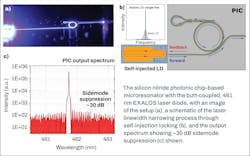EPFL researchers demonstrate visible laser diodes with a photonic chip microresonator
By injection-locking the laser diode to a silicon nitride (Si3N4) photonic integrated circuit, Swiss Federal Institute of Technology Lausanne (EPFL; Lausanne, Switzerland) researchers achieved a laser intrinsic linewidth of ~1.15 MHz and more than 100x reduction in optical phase noise. Such compact sources are of interest to the emerging quantum computing industry and for use within precision atomic clocks.
Photonic integrated circuits combining indium phosphide (InP) lasers at 1310/1550 nm and silicon waveguides are widely used for data and telecom applications to provide transmission rates of greater than 100 Gbit/s with very low power consumption and high efficiency.
But there is currently a lot of work being done to develop their visible counterparts for a wide range of applications such as augmented/virtual reality, quantum computing, biophotonics, and sensing. Since silicon has a band gap that prevents its use at visible wavelengths, Si3N4 has emerged as one of the best candidate materials for visible waveguides and PICs. It is compatible with established CMOS manufacturing technology and, with a bandgap of 4.9 eV, provides a high transmission window in the UV and visible.
The researchers used Exalos blue and green laser diodes and butt-coupled the devices to a Si3N4 photonic integrated circuit with a high-quality factor microresonator for optical feedback and mode selection. Through self-injection locking, the laser diode operates on a single longitudinal mode with a measured linewidth at 461.8 nm, for example, of ~1.15 MHz, which is comparable to the performance achieved from external cavity diode lasers using bulk optical elements (see figure).There is considerable interest in developing compact, ultralow-noise, single-frequency sources to manipulate trapped-ion/atomic quantum systems and to generate qubits.
Qubits are the fundamental building blocks of quantum computers and, unlike the binary bits of traditional computers, can exist as a superposition of two quantum states.
One type of qubit based upon single trapped atoms or ions (such as strontium, ytterbium, or calcium) is an optical qubit in which the superposition of states corresponding to different atomic/ionic energy levels is achieved by applying laser pulses of a controlled frequency and duration. The linewidth and phase noise of the laser source are critical to control the coherence time of superposition or the fidelity of the qubit for performing complex calculations. Developing a compact, low-noise optical source is key to the advancement of scalable, practical quantum computers.
The 461 nm source pioneered in this current work corresponds well to energy transitions of the strontium atom. To reduce the laser linewidth to the kilohertz regime and further improve upon the phase noise, the researchers are now exploring the use of narrower core Si3N4 waveguides with a corresponding higher-quality microresonator as well refinements of the butt-coupling approach.
About the Author
Marco Rossetti
R&D Manager, Exalos AG
Marco Rossetti, Ph.D., is R&D manager at Exalos AG (Schlieren, Switzerland), and was a graduate student at Ecole Polytechnique Fédérale de Lausanne (EPFL)’s Institute of Photonics and Quantum Electronics (Lausanne, Switzerland).

